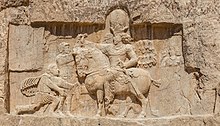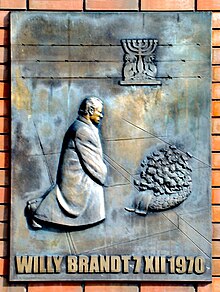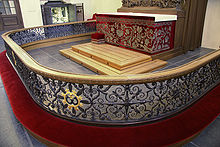Kneel down


The kneel or squat , or kneeling is a gesture of humility against a superior person, such as a king or political rulers. Often kneeling is performed as an expression of religious worship of a divinity or an advocate. Kneeling is practiced in numerous religions, both as worship and as a prayer and meditation posture . In the secular area there is kneeling down as a symbolic gesture, for example when making a marriage promise.
There are numerous forms and nuances with different symbolic and ritual meanings. The motor movements of kneeling down range from the suggestion of bending the knee ( kink ) to complete prostration (as in the prostration ). The historically evolved names of the gestures are not always clear and depend on the cultural or temporal context.
Terminology
The Latin name is Genuflexio , as Genuflexio simplex the squat with one knee, Genuflexio duplex a squat with both knees (so-called double squat). In the Middle Ages, the term Venia ("grace; forgiveness, forgiveness, excuse") was used in popular language for the kneeling, also Germanized Venia .
The prostratio (from se prosternere “prostration”) is, like the venia of some religious rites and the metania of the Orthodox churches, a different form of prostration. In the various forms of the Byzantine rite, the venia is also called metany.
Kneel down in the secular area
Political gesture of humility
Kneeling down is depicted in numerous works of art as an age-old gesture of political humility - voluntary or forced. The political opponent usually humiliates himself in front of a powerful, often victorious person (cf. the depiction of submission to Shapur I in the triumphal relief at Naqsch-e Rostam). On the other hand, Willy Brandt's kneeling in Warsaw at the memorial for the dead in the Warsaw Ghetto in December 1970, a political gesture of humility with a plea for forgiveness for the German crimes of World War II , had a completely different meaning .
Civil society protest against racism in the United States
In the summer of 2017, some blacks on American football teams began to kneel while listening to the national anthem before games in protest of discrimination and police violence, which led to a public conflict with Donald Trump , which other people outside of football also joined in solidarity. Eric Reid describes the posture as a respectful gesture intended to remind of a flag that was raised at half-mast due to a tragedy .
Punish
Until the 20th century, kneeling on a log was a way of punishing students in schools.
Kneel down in the religious realm
Antiquity
Both Greeks and Romans refused to kneel before their gods . Kneeling was unworthy of a free Roman or ancient citizen and was a matter of the barbarians , Jews or Christians who lived in these realms. Plutarch and Theophrastus of Eresos characterize kneeling as an expression of superstition . Aristotle calls it a barbaric form of behavior.
Judaism
There are several descriptions of kneeling in the Tanakh , for example: “He [Solomon] stepped [on the platform], got down on his knees in the face of the whole assembly of Israel, spread his hands to heaven and prayed: Lord, God of Israel, In heaven and on earth there is no God who, like you, keeps covenant and grace to his servants who live before him with an undivided heart. "( 2 Chr 6,13-14 EU ) or" Come, let us fall down, us bow down to him, let us kneel down before the Lord our Creator! "( Ps 95 : 6 EU )
Since the Standing an old expression during prayer according to Jewish tradition reverence is, people are frequently in prayer as they kneel. An example of this is the eighteen supplication prayer , which is also known as amida (“standing prayer”). The Hebrew word calc for knee is related to the word bracha ("blessing"). For the Hebrews, the knees were a symbol of strength; the bending of the knees is thus the bending of strength before the living, one and only God.
Christianity
Three attitudes can be distinguished in the Bible that are closely related to the word "kneel". The prostration - the self-to-ground distances to the overwhelming power of God - that in the New Testament occurring to-feet-traps and the knees. In detail, of course, the three attitudes cannot always be clearly separated from one another. The word kneel ( Greek προσκυνεῖν proskynein ) occurs 59 times in the New Testament alone, of which 24 times in the Revelation of John . The Greek term actually means "kissing", but was already used in New Testament times to mean "to show honor by prostrating". "The disciples in the boat, however, fell down before Jesus and said: Truly, you are the Son of God." ( Mt 14.33 EU )
Another important event in which kneeling is mentioned in the New Testament is the prostration of Jesus on the Mount of Olives before his passion: “And he went a little further, threw himself down on the earth and prayed that the hour, if possible, would come pass him by. "( Mk 14.35 EU )
Roman Catholic Church
Simple squat
In church, Catholics do a simple squat (with one knee to the floor) in front of the Blessed Sacrament kept in the tabernacle , or in the direction of the tabernacle, before going to the pew, when they pass in front of the tabernacle, and when they return to the church leave. The place of the tabernacle is indicated by the eternal light .
Celebrants , deacons and the liturgical services ( acolytes , lecturers , communion helpers ) bow their knees before the holy of holies when they enter the church together and when they leave , thus testifying to the reverence for the presence of the almighty, triune God.
“In the liturgy of the Mass we express our faith that Christ is really present under the figures of bread and wine, among other things by bowing our knees or bowing deeply as a sign of adoration of the Lord. ( Catechism of the Catholic Church , 1378) "
The basic order of the Roman missal (GRM 274) also states:
“The squat, in which the right knee is bent to the floor, is an expression of worship; it is therefore reserved for the Blessed Sacrament and the Holy Cross from the solemn adoration during the liturgical celebration of the Friday of the Passion of the Lord until the beginning of the Easter Vigil . "
Double squat
With the double knee bend (Genuflexio duplex) the left knee is also bent, both knees touch the floor next to each other and you bend. The double squat is practiced in front of the exposed Blessed Sacrament, when the Blessed Sacrament is carried past, or during the sacramental blessing .
Kneel down
If the person praying stays longer in the double knee bend, one speaks of kneeling down.
In Roman Catholic churches, in addition to the benches, there are usually kneeling benches, which were set up to provide relief to believers who would find it too difficult to kneel on the bare floor. It is common to kneel not only in the appropriate places in the liturgy , but also during silent prayer in the church.
In the Holy Mass the Eucharistic gifts become the body and blood of Christ ( transubstantiation ) during the conversion , therefore the believers should kneel at least during the consecration until the cry " Your death ... ". In some places it is customary to kneel from the Agnus Dei to communion, also when receiving communion at the communion bench .
You always kneel when the deacon , the ceremonial or the celebrant asks to do so with “bend your knees”, as well as at Christmas and on the solemnity of the Annunciation when declaring the creed about the Incarnation of Christ , on Palm Sunday and Good Friday during the Passion after the passage that describes the death of Jesus at Pentecost to the call to the gospel “Come, Holy Spirit”.
Eucharistic adoration before the tabernacle or the exposed Blessed Sacrament occurs while kneeling. People also kneel down as much as possible for a sacramental blessing , for example during Eucharistic processions .
In addition, kneel when receiving some sacraments (about the Sacrament of Penance and the sacrament of ordination ) and some sacramentals of particular importance, such as the bride's blessing, the profession or the virginal consecration and in the Liturgy of the Hours in the words of Invitatoriums "Let fall us ourselves before Him bow down, let us kneel down before the Lord our Creator! "
Kneeling (venie)
When kneeling (also with the special shape of the footfall ), kneeling is performed quickly. Peter Dinzelbacher describes this practice among others as part of the ascetic practices that were widespread in the Middle Ages . The expression “Venie” (also medium lat. “Venia”) has been used to describe the kneeling position since the Middle Ages.
The venie as an expression of adoration, devotion and pleading is part of some of the rites and pious exercises of the Latin Church. In the various forms of the Byzantine rite, the venie is also called metany.
Other forms of prostration
A form of kneeling, a sliding movement on the knees, occurs in church customs as a sign of penance during pilgrimages , where pilgrims kneel around the church or circle the altar three times at their destination. The Scala Santa in the Roman Lateran may only be climbed on your knees, as can "holy stairs" based on this model , for example in Bonn, Salzburg and in several Bavarian towns.
Prostratio is a special form of prostration, the prostration of a person stretched out as a sign of humility, devotion and pleading. It has its place in the liturgy at the beginning of the celebration of the passion and death of Christ on Good Friday , when receiving the sacrament of consecration as well as when taking solemn religious vows and the consecration of virgins , in some orders also in the prayer of the hours when high feasts are announced from the martyrology .
Orthodox churches
Kneeling is not common in the Sunday liturgy, but rather the Pojasnoi Poklon (small Metanie ): half the bow with touching the ground and sign of the cross. On other days of the week there are prostrations (metania) in some churches, as the Roman Catholic Church knows them as prostration . Orthodox practice to this day preserves the provisions of early Christianity, according to which kneeling is inappropriate on Sunday as the feast day of the resurrection of Jesus Christ and the entire "Pentekoste" (time from Easter to Pentecost); so determined by the First Council of Nicaea in its can. 20, to which the Orthodox Churches feel obliged.
Confessional Lutheran Churches
- See also squat fight
Squat
The squat is performed in confessional Lutheran churches (these are Lutheran churches of old denomination , such as the Independent Evangelical Lutheran Church ) by the pastor as part of the celebration of Holy Communion . During the consecration , according to the word of bread and the word of the cup, the elevation takes place as a rite to show the really present true body and blood of Christ. After elevating the gifts, the pastor does a squat. Some church members also practice a squat before receiving Christ's body and blood in Holy Communion, before kneeling at the altar for communion .
Kneel
Kneeling is a common practice in denominational churches. Kneeling is done in appropriate places in the Lutheran liturgy. If a sermon service is celebrated, people kneel during the preparation prayer at the beginning of the service. As part of the general confession in or before the Lutheran Communion Service, the confessing community kneels during the confessional prayer, the so-called confessional questions and then at the altar to receive the holy absolution by the pastor with the laying on of hands. Usually the pastor kneels at the altar during the song before the sermon and asks for the Holy Spirit for his ministry.
During the celebration of the Lord's Supper, the congregation kneels during the consecration words. In some churches it is also customary to kneel during the Lord's Prayer. The congregation also kneels during the song Christe, you Lamb of God, out of awe of the body and blood of Christ, which is really present in Holy Communion. In a few congregations, the congregation kneels as a blessing at the end of the sacrament service.
In addition to these described opportunities during the Sunday service, Lutheran churches also kneel for special acts of blessing, such as B. the church wedding, the confirmation , in the context of the act of baptism (parental or mother blessing), ordination .
Reformed churches
As a rule, there are no knee benches in Reformed churches . According to Calvin and Zwingli, the rite should be freed from what was not expressly laid down in the Bible, including kneeling in worship , especially at the Lord's Supper . The communion is received by the congregation standing around a table.
Buddhism and Hinduism
In Buddhism and Hinduism , kneeling is understood as a posture during meditation .
Islam
In Islam the knees during is prayer on a prayer rug usual. However, as in Christianity, it is not about kneeling with an upright posture, but rather sitting on knees and feet when prostrating.
See also
literature
- Henri de Lubac : Corpus mysticum. L'Eucharistie et l'Église au Moyen âge. Étude historique . 2. édition revue et augmente. Éditions Montaigne, Paris 1949, ( Theology 3).
- Jose Antonio Sayes: La presencia real de Cristo en la eucaristia . Ed. Católica, Madrid 1976, ISBN 84-220-0781-5 , ( Biblioteca de autores cristianos 386).
- Michel Sinoir: La prière à genoux dans l'Ecriture Sainte . In: Sedes sapientiae 15, 1997, Fasc. 4, No. 62, ISSN 0751-6681 , pp. 37-72, (also reprint: Tequi, Paris 1997).
- Prasanna Vazheeparampil: The Making and Unmaking of Tradition. Towards a theology of the liturgical renewal in the Syro-Malabar church . Mar Thoma Yogam, Rome 1998, (also: Rom, Pontifical Oriental Inst., Diss., 1998).
- L. Michael White: Building God's House in The Roman World. Architectural adaptation among pagans, Jews, and Christians Published for the American Schools of Oriental Research by Johns Hopkins University Press, Baltimore Md. 1990, ISBN 0-8018-3906-8 , ( ASOR library of biblical and Near Eastern archeology ).
Web links
- General introduction to the Roman Missal ( Memento from May 22, 2012 in the Internet Archive ) German Liturgical Institute, accessed on May 30, 2017
- Kneel
Individual evidence
- ^ Niermeyer / van de Kieft: Mediae Latinitatis Lexicon minus. Vol. II. (Reprint, second revised edition 2002) writes on p. 1397: venia = prosternatio "Fußfall, Kniefall" and brings a passage from Petrus Venerabilis , according to which the squat in front of someone who wears the holy of holies , and the squats in the daily debt chapter of monasteries would be called vulgo veniae , "popularly Venia".
- ↑ Hubert Wetzel: American Football: The New American front in Sport In: Süddeutsche Zeitung , September 25 2017th
- ↑ Eric Reid: Opinion | Eric Reid: Why Colin Kaepernick and I Decided to Take a Knee . In: The New York Times . September 25, 2017, ISSN 0362-4331 ( nytimes.com [accessed October 17, 2017]).
- ↑ zeit-online 35 (2012) ; histo-couch.de
- ^ Josef Ratzinger: Der Geist der Liturgie , Herder-Verlag, Freiburg 2002.
- ↑ “They [the believers] have to kneel during the consecration , unless they are prevented from doing so for health reasons, because of the confined space, a larger number of people present or for other reasonable reasons. But whoever does not kneel for the consecration has to bow deeply, while the priest does a squat after the consecration. (GRM 43) ".
- ↑ Peter Dinzelbacher (1994). Christian mysticism in the west. Your story from the beginning to the end of the Middle Ages. Schöningh, Paderborn, p. 297.
- ^ Franz Pfeiffer (ed.). German mystics of the fourteenth century: Vol. 1. Leipzig. Göschen's publishing house. 1845. p. 416, keyword “venie”. Here, “venie” also expressly refers to the squat. Matthias Lexer (1992). Middle High German pocket dictionary, keyword: venja, venige, venge: kneeling down to prayer, kneeling prayer (lat: venia). Ernst Hennig (1806). The statutes of the Teutonic Order, p. 307. https://books.google.de/books?id=OK1AAAAAcAAJ .
- ^ Eduard Hoffmann-Krayer, Hanns Bächtold-Stäubli: Concise dictionary for German folklore. Department 1. Superstition. Berlin / Leipzig 1931/32, p. 1575, keyword “kneeling”. https://books.google.de/books?id=273dX4-VRJAC&pg=PA289&lpg=PA289&dq=kniebeuge+in+der+katholischen+kirche+venie&source=bl&ots=BA26mOKtko&sig=HxzKwhWFW1MRazhYDBriT2ZoL4A&hl=de&sa=X&ved=0ahUKEwjn9qbyjcTbAhXDF5oKHZ43DV8Q6AEIRzAD#v=onepage&q= venie & f = false








